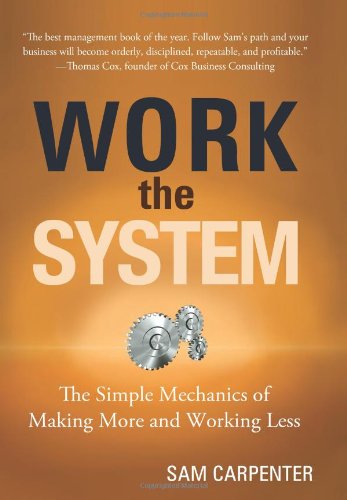Work the System Summary
5 min read ⌚

The Simple Mechanics of Making More and Working Less
Have you ever felt that no matter how much time of your week you spend working, there’s always some work left?
And that, regardless of how much you try, stress never seems like anything even remotely motivating?
And does a 4-hour workweek sound like an SF fantasy to you?
Well, Sam Carpenter says, it doesn’t need to! Because, according to him, there’s a way to work the system.
Who knows: maybe that’s why he used the very same title for his book?
Let’s find out!
Who Should Read “Work the System”? And Why?
The three-step procedure expounded in “Work the System” is applicable in almost any area of life. Including, probably, life itself.
However, the greater the number of procedures required to be regulated for a system to work, the less applicable these timeless Carpenter’s ideas are.
So, small-business owners and people who plan to constrain their choices and keep life simple will find this book most useful. However, large businesses and people who plan things out may give the system a go as well.
About Sam Carpenter
 Sam Carpenter is the CEO of Centratel, a large telephone answering service, and the president of few other smaller organizations: a consulting firm, a social media service, and an SEO marketing company.
Sam Carpenter is the CEO of Centratel, a large telephone answering service, and the president of few other smaller organizations: a consulting firm, a social media service, and an SEO marketing company.
He manages each of them in full accordance with the system mindset, described in detail in “Work the System.”
In addition to revising and updating his first book, recently, Carpenter published its sequel, “The Systems Mindset.”
“Work the System Summary”
Let us begin our summary with a provocative quote by Carpenter:
“Each thing we do is a component of a system.”
Some of these systems are simple; some are utterly complex. And, it’s for you to find out! Because, one way or another, both are manageable.
Just think of your body, for example!
What you do daily may seem simple, but – It’s the product of perfect coordination between different organs and hormones. Each of these organs is, in turn, a collection of tissues.
And tissues are cellular organizations. Cells may be the building blocks of life, but they themselves are a system of atoms. Atoms, too, are composed of protons, neutrons, and electrons.
We can move to quantum level or talk about the universe and the whole history of time, but you probably got the drill by now!
Now, due to the enormous amounts of time evolution, the blind watchmaker, had to organize everything around, it did a hell of a good job! And many things, including you, now work like a clockwork.
But, so do some Western societies – and these were created by men! News flash: they are a lot more complex than your company or your life.
The reason why they work better than your life is because hosts of people have organized them better. Or, as Carpenter says: “Your life is composed of systems that are yours to control – or not control.”
And there are few reasons why your body, the American justice system, or the Israeli start-up community, is better organized than your workweek!
First of all, they are aware of their complexity, and they are subdivided into many subsystems. Each of these systems is segmented too until there’s a sub-subsystem which can be organized straightforwardly.
How?
By documenting its strategic objectives, general operating principles, and, finally, its working procedures. Once this is done and people start following them, we come to a full circle regarding the original system.
Time for another Carpenter quote:
“Creating efficient subsystems should cause the primary system to be efficient, too.”
Sure, there are some exceptions, but just think how worse life would have been in the absence of proper documentation detailing the stages of a process! We need guidelines! That’s why emergency manuals are step-by-step instructions. And, that’s why people follow them blindly – at least until they find a better alternative.
And you should take your life as seriously as you would in the case of an earthquake! On a daily basis!
So, put everything down in writing! Identify the best-working procedure in any subsystem of your company (or life, for that matter) and write a step-by-step manual. May it be as precise as possible so that even new employees are able to understand it and implement it in a simple manner.
Adorn the manual with a general operating principles sheet. This way, employees will be allowed to be creative and search for even more efficient solutions, while not breaking the company’s more wide-ranging codes.
Finally – or, better yet, primarily – think of your strategic objectives. These are the most important. They are the story, the tradition around which your company is built.
Key Lessons from “Work the System”
1. Everything Is Mechanical and Fixable
2. Work the System: Document Everything
3. Before and After All, Few Important Considerations
Everything Is Mechanical and Fixable
Perhaps, this is the most important lesson you should learn from Carpenter’s book. Namely, whether it’s the universe or your body, everything is a system comprised of subsystems.
The same is true for your company, your life, and, at least for the time being, your body.
The good thing about systems?
They’re mechanical. Namely, if you understand their structure, you can control them.
Or even reimagine them.
Work the System: Document Everything
So, do that!
First, work out – and then work the systems of your company, your life, everything else.
Just like hackers do, first, find the holes in the original structure. Then, fix them and find out how you can use them to your benefit. Finally, write the procedure for the others.
The winning formula: record-scrutinize-maintain.
Before and After All, Few Important Considerations
Now, maintaining systems is not for everybody.
And it’s definitely not an easy task. So, Carpenter has few precautionary and corrective considerations.
First of all, don’t expect your procedures to be perfect from the start. Secondly, once you mark out your system, be disciplined and follow it; don’t procrastinate. Thirdly, systems are great trainers. So, don’t look for perfect employees: wait for them to become ones.
Finally, expect mistakes and failures. No system can ever help you overcome all of them.
Just like no system will ever help you make the right decision when some significant change occurs.
Like this summary? We’d Like to invite you to download our free 12 min app, for more amazing summaries and audiobooks.
“Work the System” Quotes
The “Work the System methodology relies on the personal habit of consistency, the child of character and self-discipline. Share on X The mantra of the Work the System method is to isolate-fix-maintain. It is not enough to know what to do. One must take action. Share on X There is a direct connection between happiness and the amount of control we attain. Share on X Do some organizing every day, even if it’s for just 15 minutes each time. Share on X It’s not mysterious bad luck that takes people down; it’s serial inefficiency. Share on XOur Critical Review
In more aspect than one, “Work the System” is a refreshing business management/self-help book. First of all, almost none of it is theoretical or mystical, contributing to an almost instant appeal.
Consider us old-fashioned, but we like authors with “do-or-die” attitude in terms of the success of their books. Carpenter sets things straight from the start, leaving no room for excuses afterward. It’s as if his book is trying to say a fairly simple thing.
Something like: “You see, guys, my methods are mechanical and straightforward, and, since they’ve worked for me, they should work for you too. Try them!” No “search deep inside”-s, no “you’ve not visualized success hard enough”-s.
Really! Just see the blurb!
In fact, even better: read the book. Because you don’t even have to buy it. Whether you prefer an electronic or an audio version, you can get it for free at workthesystem.com.
And if it doesn’t work – well, you don’t have to worry you’ll lose anything!
Emir is the Head of Marketing at 12min. In his spare time, he loves to meditate and play soccer.







